
Omusati is one of the fourteen regions of Namibia, its capital is Outapi. The towns of Okahao, Oshikuku and Ruacana as well as the self-governed village Tsandi are situated in this region. As of 2020, Omusati had 148,834 registered voters.

The Cunene or Kunene is a river in Southern Africa. It flows from the Angola highlands southwards to the border with Namibia. It then flows in a westerly direction along the border until it reaches the Atlantic Ocean.
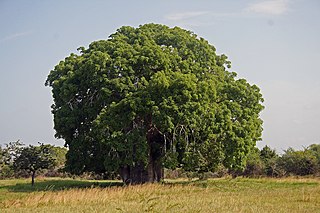
Adansonia is a genus made up of eight species of medium-to-large deciduous trees known as baobabs or adansonias. They are placed in the Malvaceae family, subfamily Bombacoideae. They are native to Madagascar, mainland Africa, and Australia. The trees have also been introduced to other regions such as Asia. A genomic and ecological analysis has suggested that the genus is Madagascan in origin.

Adansonia gregorii, commonly known as the boab and also known by a number of other names, is a tree in the family Malvaceae, endemic to the northern regions of Western Australia and the Northern Territory of Australia.

The Îles de la Madeleine lie west of Dakar in Senegal. The islands are uninhabited. The main island is Sarpan, known for its Stone Age tool finds. The islands are also known for their birds, fish and plant life. The cliffs are steep, and had been carved by the sea over millions of years. Îles de la Madeleine National Park is one of the smallest national parks in the world.

Bardon is a civil parish and former village in North West Leicestershire about 1.5 miles (2.4 km) southeast of the centre of Coalville. The parish includes Bardon Hill, which at 912 feet (278 m) above sea level is the highest point in Leicestershire. With the population remaining less than 100, information from the 2011 census was included in the civil parish of Ellistown and Battleflat.

Morondava is a city located in Menabe Region, of which it is the capital, in Madagascar. It is located in the delta of the Morondava River at 20°17′5″S44°19′3″E. Its population as of the 2018 census, was 53,510.

Adansonia digitata, the African baobab, is the most widespread tree species of the genus Adansonia, the baobabs, and is native to the African continent and the southern Arabian Peninsula. These are long-lived pachycauls; radiocarbon dating has shown some individuals to be over 2,000 years old. They are typically found in dry, hot savannas of sub-Saharan Africa, where they dominate the landscape and reveal the presence of a watercourse from afar. They have traditionally been valued as sources of food, water, health remedies or places of shelter and are a key food source for many animals. They are steeped in legend and superstition. In recent years, many of the largest, oldest trees have died, for unknown reasons. Common names for the baobab include monkey-bread tree, upside-down tree, and cream of tartar tree.
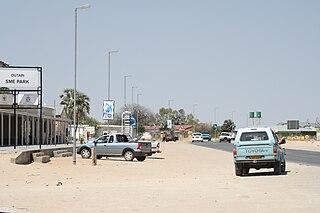
Outapi wa Nakafingo na Temba, also Outapi or Uutapi and Ombalantu, is a town in northern Namibia near the border with Angola, situated 90 km (56 mi) northwest of Oshakati. It is the capital of the Omusati region and the district capital of the Outapi electoral constituency. The language spoken there is Oshiwambo.
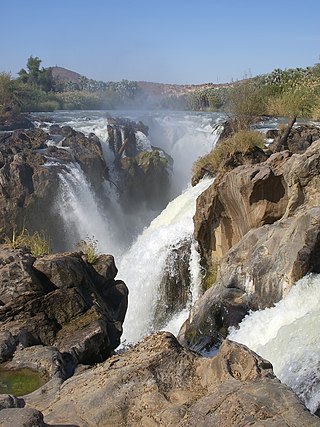
Epupa Falls is a series of large waterfalls formed by the Cunene River on the border of Angola and Namibia, in the Kaokoland area of the Kunene Region. The river is about 0.5 kilometres (1,600 ft) wide in this area and drops in a series of waterfalls across a length of 1.5 kilometres (0.93 mi), with the greatest single drop being 37 metres (121 ft). The settlement near the falls is also called Epupa.

Adansonia za is a species of baobab in the genus Adansonia of the family Malvaceae. It was originally named in French as anadzahé. Common names in Malagasy include bojy, boringy, bozy, bozybe, ringy, and za, the last of which gives the plant its specific epithet. Eight Adansonia species are recognized, with six endemic to Madagascar. Adansonia za is the most widespread of the Madagascar endemics.

Mapungubwe National Park is a national park in the Limpopo Province, South Africa. The park protects the historical site of Mapungubwe Hill, which was the capital of the Kingdom of Mapungubwe, as well as the wildlife and riverine forests along the Limpopo River. The Mapungubwe Hill was the site of a community dating back to the Iron Age. Evidence has shown that it was a prosperous community. Archaeologists also uncovered the famous Golden Rhinoceros of Mapungubwe figurine from the site.
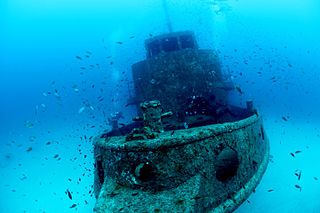
MV Rozi was a tugboat, built in Bristol in 1958. She was originally called Rossmore, and was later renamed Rossgarth. She was sold to Tug Malta in 1981 as the Rozi and operated in the Grand Harbour. After being decommissioned, in 1992 she was scuttled off Ċirkewwa as an artificial reef. It is now one of the most popular dive sites in Malta.

Boltenhagen (GS09) was a Kondor I-class minesweeper built in East Germany. After the Volksmarine was disbanded just before the reunification of Germany, she was sold to Malta in 1997 and renamed P29 and was used as a patrol boat. After being decommissioned, she was scuttled as a dive site in 2007 off Ċirkewwa.
Tsandi is a village in the Omusati Region of northern Namibia and the district capital of the Tsandi electoral constituency. It is a former mission station of the Finnish Missionary Society. It is situated on the main road MR123.
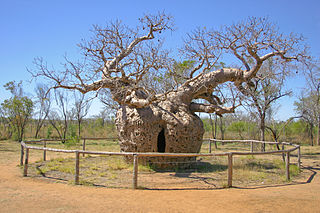
The Baobab Prison Tree, Derby is a 1,500-year-old, large hollow Adansonia gregorii (Baobab) tree 6 kilometres south of Derby, Western Australia with a girth of 14.7 metres. It had been reputed to have been used in the 1890s as a lockup for indigenous Australian prisoners on their way to Derby for sentencing, but there is no evidence that it was ever used to house prisoners.
Nakayale, also known as Nakayale Keengulu is a village in northern Namibia near Outapi in Omusati Region situated 86km northwest of Oshakati and 4km from Outapi. It is in Anamulenge Constituency.
The Dorsland tree, also known as the Dorsland Baobab and the Dorsland Grootboom, is a baobab tree in Namibia which is found to the south of the Khaudum National Park. At around 2,100 years old, it is believed to be the oldest tree in the country. It is 14.3 m (47 ft) high, has a circumference of more than 30 m (98 ft) and keeps growing despite having fallen over. In 2006, two of its oldest relatives died. The previous oldest tree in the country, known as Grootboom, was 32 m (105 ft) high, but died in 2005.
Josafat Shanghala (Kashindi) (b. 8 June 1944 Nakayale, Outapi, Ombalantu, Namibia) is a bishop emeritus of the Evangelical Lutheran Church in Namibia.















